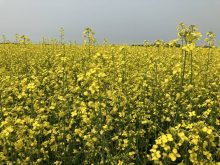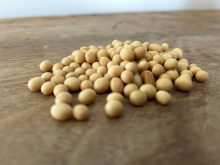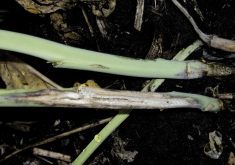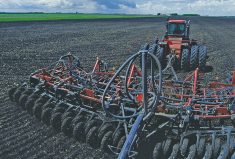Blackleg has become an expensive problem for canola producers, but growers will soon have two new tools to reduce the economic impact of the disease.
“Blackleg wasn’t a real concern even a few years ago, but now it’s becoming increasingly important,” said Stephen Strelkov, a professor of plant pathology at the University of Alberta. “This can allow us to relate back to how disease levels correspond to yield loss numbers and to quantify the importance of blackleg in particular years.”
The first is a yield loss model that estimates the production that can be expected based on the severity of the disease in their fields.
Read Also

Hail research hopes to benefit potato growers
Alberta research scientist measures hail storm and heat dome affects on potato crops
“This is the first blackleg yield loss model that has been developed for Western Canada,” said Strelkov.
Over the course of three years at multiple locations, his team grew canola cultivars that were either susceptible, moderately resistant, or resistant to blackleg. They then rated the severity of the disease on a scale of one to five.
Unsurprisingly, there was “quite a straightforward relationship” between disease severity and yield losses, he said.
“As blackleg severity increases, the pod number and seed yield decreased in a linear fashion,” he said. “When we did the analysis over multiple site years, we found with the susceptible check that, for each unit increase in disease severity (on the one to five scale), there was a 17 per cent decline in yield.”
And (again unsurprisingly), the yield losses were significantly higher in the susceptible varieties, he added.
“Blackleg severity was lower and seed yield was over 120 per cent greater in moderately resistant and resistant varieties versus the susceptible checks.”
The Canola Council of Canada is now using the model to determine how economically important blackleg is to Canada’s canola sector. The hope is it will give producers a tool that accurately estimates losses so they can “make informed crop management decisions,” Strelkov said.
“It’s not predicting whether or not there’s going to be blackleg. It’s not a risk model. But it’s useful to know that if you have X amount of disease, it’s going to cost X amount in yield loss.”
Blackleg race test
The second new tool will make it easier for producers to match the race of blackleg in their field with the resistance in the varieties they choose.
“Over the last decade or so, our understanding of the genetics involved in the interaction between the fungal pathogen for blackleg and canola has really leapt forward,” said Nick Larkan, a researcher at Armatus Genetics in Saskatoon.
“We’re at the point where we have enough information to be able to predict how different races of the fungus will react to the different canola varieties that are on the market.”
One of the best ways to manage blackleg is through rotation, he said — “not just rotation of different crops, but rotation of different varieties as well.”
Up until now, producers have had to do that almost completely blindly, he said.
“There’s quite a large risk that, in selecting a new variety of canola, they might actually still be using the same resistance.”
But with a simple lab test of infected plants, producers can determine which strain of blackleg is present in their field and choose the right resistant variety. The canola council has also been encouraging seed companies to label their bags with the resistant genes they use in their varieties, which will help as well.
“Once a producer has the information on the races of the pathogen that are in the field and the different resistances that are available to him in canola varieties, he’s able to pick a suitable variety for his field,” said Larkan.
The test will be available for the 2018 growing season, he added.
“The technology has been transferred to a number of testing labs around the Prairies and is being launched as a commercial test for producers,” he said. “It will be a widely available commercial test for producers across the Prairies by spring.”















